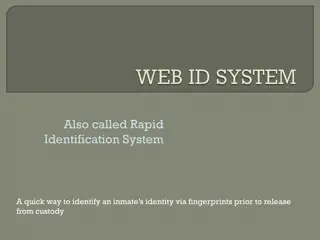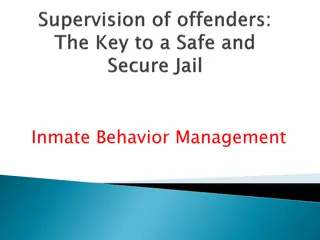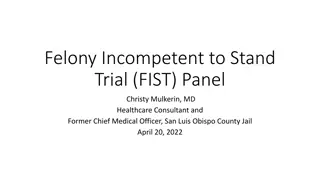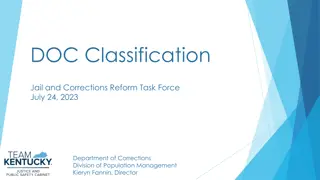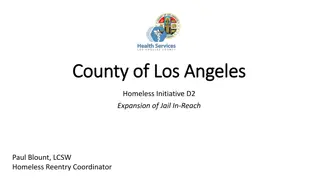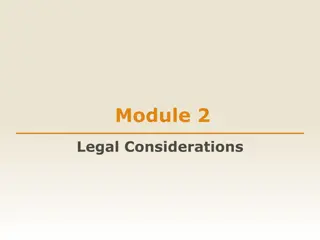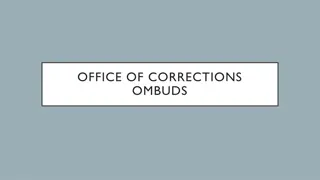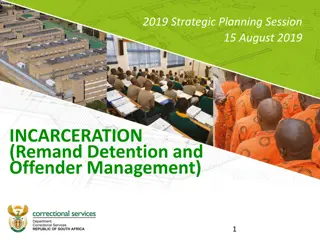Understanding Inmate Health Care and Jail Conditions
Inmate health care and jail conditions are crucial aspects of the criminal justice system. This presentation delves into the treatment of prisoners, focusing on humane living conditions, safety, health care, and freedom rights. It emphasizes the importance of proper intake screening for medical and mental health issues, along with the legal obligations of providing treatment to inmates with pre-existing conditions.
Download Presentation

Please find below an Image/Link to download the presentation.
The content on the website is provided AS IS for your information and personal use only. It may not be sold, licensed, or shared on other websites without obtaining consent from the author. Download presentation by click this link. If you encounter any issues during the download, it is possible that the publisher has removed the file from their server.
E N D
Presentation Transcript
TOPICS Inmate Health Care Inmate Suicide Sexual Misconduct Excessive Force Jail Conditions
Many states and counties across the U.S. have legislatively mandated jail standards or voluntary jail standards governing jail conditions of confinement and operations. There are also many states that have their own home grown detention standards, such as New Mexico. Other states rely on American Correctional Association Detention Standards or Sheriff s Association Standards. For the purpose of this presentation I will be referencing the American Bar Association Criminal Justice Standards on the Treatment of Prisoners, dated February 2010 and excerpts from the book on Civil Liberty and Criminal Justice by Taylor and Francis, as well as my own expertise and that of others that I work with in the field.
The treatment of inmates/prisoners The basic areas of conditions of confinement are included in the following: humane and healthful living conditions; safety from harm, including protection from punitive or excessive force and protection from abuse by other prisoners and staff; necessary health care; freedom from staff harassment and discrimination and freedom of religion and substantial freedom of expression
Inmate Health Care Prisoner Intake Pre-existing medical conditions Mental Health care Substance Abuse Diagnostics Treatment
The topic of Inmate Health Care is a high risk component in a detention center. An inmate s incarceration starts at intake/booking. This is where inmates are initially screened for medical issues, mental health issues, special needs, safety needs and security needs. Typically, and best practice is for qualified medical and mental health staff to conduct the initial intake screening of inmates for medical and mental health. Relying solely on custody staff to perform this function can be risky. In small jails, where there may not be medical or mental health staff available 24/7 custody staff can, if properly trained by qualified health care staff, perform initial medical health screening of newly admitted inmates. However, the screening forms should be reviewed by qualified health care staff as soon as possible.
The initial screening should include issues requiring immediate assessment or attention, such as illness, communicable diseases, mental health problems, drug or alcohol intoxication or withdrawal, ongoing medical treatment, risk of suicide, special education eligibility, identifying the prisoner's immediate potential security risks, including vulnerability to physical or sexual abuse. The question arises; do jails have to provide treatment to inmates that have pre- existing medical conditions? The short answer is generally yes. For example if a newly committed inmate has a pre-existing medical condition that is causing dysfunction or pain, he or she must be treated. Also, if an inmate comes in with asymptomatic disease such as, diabetes or high blood pressure, those medical conditions need to be addressed.
In a joint report by the Treatment Advocacy Center and the Texas Sheriffs Association entitled: The Treatment of Persons with Mental Illness in Prisons and Jails: A State Survey, dated April 8, 2015 I believe framed the mentally ill dilemma in jails and prisons very succinctly as follows: Prisons and jails have become America s new asylums : The number of individuals with serious mental illness in prisons and jails now exceeds the number in state psychiatric hospitals tenfold. Most of the mentally ill individuals in prisons and jails would have been treated in the state psychiatric hospitals in the years before the deinstitutionalization movement led to the closing of the hospitals, a trend that continues even today. The treatment of mentally ill individuals in prisons and jails is critical, especially since such individuals are vulnerable and often abused while incarcerated.
Untreated, their psychiatric illness often gets worse, and they leave prison or jail sicker than when they entered. Individuals in prison and jails have a right to receive medical care, and this right pertains to serious mental illness just as it pertains to tuberculosis, diabetes, or hypertension. This right to treatment has been affirmed by the U.S. Supreme Court. The Treatment of Persons with Mental Illness in Prisons and Jails is the first national survey of such treatment practices. It focuses on the problem of treating seriously mentally ill inmates who refuse treatment, usually because they lack awareness of their own illness and do not think they are sick. What are the treatment practices for these individuals in prisons and jails in each state? What are the consequences if such individuals are not treated?
To address these questions, an extensive survey of professionals in state and county corrections systems was undertaken. Sheriffs, jail administrators, and others who were interviewed for the survey expressed compassion for inmates with mental illness and frustration with the mental health system that is failing them. There were several other points of consensus among those interviewed: Not only are the numbers of mentally ill in prisons and jails continuing to climb, the severity of inmates illnesses is on the rise as well. Many inmates with mental illness need intensive treatment, and officials in the prisons and jails feel compelled to provide the hospital-level care that these inmates need. The root cause of the problem is the continuing closure of state psychiatric hospitals and the failure of mental health officials to provide appropriate aftercare for the released patients.
To address these questions, an extensive survey of professionals in state and county corrections systems was undertaken. Sheriffs, jail administrators, and others who were interviewed for the survey expressed compassion for inmates with mental illness and frustration with the mental health system that is failing them. There were several other points of consensus among those interviewed: Not only are the numbers of mentally ill in prisons and jails continuing to climb, the severity of inmates illnesses is on the rise as well. Many inmates with mental illness need intensive treatment, and officials in the prisons and jails feel compelled to provide the hospital-level care that these inmates need. The root cause of the problem is the continuing closure of state psychiatric hospitals and the failure of mental health officials to provide appropriate aftercare for the released patients.
Among the findings of the survey are the following: From 1770 to 1820 in the United States, mentally ill persons were routinely confined in prisons and jails. Because this practice was regarded as inhumane and problematic, until 1970, such persons were routinely confined in hospitals. Since 1970, we have returned to the earlier practice of routinely confining such persons in prisons and jails. In 2012, there were estimated to be 356,268 inmates with severe mental illness in prisons and jails. There were also approximately 35,000 patients with severe mental illness in state psychiatric hospitals. Thus, the number of mentally ill persons in prisons and jails was 10 times the number remaining in state hospitals.
In 44 of the 50 states and the District of Columbia, a prison or jail in that state holds more individuals with serious mental illness than the largest remaining state psychiatric hospital. For example, in Ohio, 10 state prisons and two county jails each hold more mentally ill inmates than does the largest remaining state hospital. Problems associated with incarcerating mentally ill persons include: Jail/prison overcrowding resulting from mentally ill prisoners remaining behind bars longer than other prisoners Behavioral issues disturbing to other prisoners and correctional staff Physical attacks on correctional staff and other prisoners Victimization of prisoners with mental illness in disproportionate numbers
Problems associated with incarcerating mentally ill persons include: Deterioration in the psychiatric condition of inmates with mental illness as they go without treatment Relegation in grossly disproportionate numbers to solitary confinement, which worsens symptoms of mental illness Jail/prison suicides in disproportionate numbers Increased taxpayer costs Disproportionate rates of recidivism
Prison and jail officials thus have few options. Although they are neither equipped nor trained to do so, they are required to house hundreds of thousands of seriously mentally ill inmates. In many cases, they are unable to provide them with psychiatric medications. The use of other options, such as solitary confinement or restraining devices, is sometimes necessary and may produce a worsening of symptoms. Yet, when things go wrong, as they inevitably do, the prison and jail officials are blamed. The present situation is unfair to both the inmates and the officials and is untenable. The ultimate solution to this problem is to maintain a functioning public mental health treatment system so that mentally ill persons do not end up in prisons and jails. To this end, public officials need to:
Reform jail and prison treatment laws so inmates with mental illness can receive appropriate and necessary treatment just as inmates with medical conditions receive appropriate and necessary medical treatment. Implement and promote jail diversion programs such as mental health courts. Use court-ordered outpatient treatment (assisted outpatient treatment/AOT) to provide the support at-risk individuals need to live safely and successfully in the community. Encourage cost studies to compare the true cost of housing individuals with serious mental illness in prisons and jails to the cost of appropriately treating them in the community. Establish careful intake screening to identify medication needs, suicide danger, and other risks associated with mental illness. Institute mandatory release planning to provide community support and foster recovery. Provide appropriate mental illness treatment for inmates with serious psychiatric illness.
Research reveals that inmate suicides in jails are 5 to 16 more likely that in free society. Between 1978 and 1998 suicides accounted 31 per cent of the in custody deaths in jails and police lockups which was an average of approximately 134 suicide deaths yearly. Inmate suicides can be costly events for counties.
Jails can mitigate suicides and payouts if they have an effective suicide prevention program in place to include the following: a comprehensive intake screening process for suicidal ideation (ensuring proper identification of potential suicidal inmates) a well thought out suicide prevention policy ensuring that all jail staff receive initial and on-going training on the suicide prevention policy ensuring that the location where suicidal inmates are placed is free of objects or fixtures where inmates can tie a ligature ensure that mental health staff coordinate with custody staff on handling suicidal inmates (monitoring of the inmate in a safe and visible location)
Prisoner Suicide Awareness Factors: Nature of arrest/transporting from transporting officer Prisoner's mental state/mental health history Prisoner expresses feelings of hopelessness Prisoner expresses he is thinking about killing himself Prisoner's history of suicide attempts Prisoner's intoxicated state Prisoner shows signs of depression Prisoner shows concern about a loss: a job, family, position in community, etc. Prisoners behavior is anxious, afraid, angry strange Prior arrests and convictions Prisoner's medical/medication history Prisoner charged with a "shocking" crime
Staff sexual misconduct in jails and prisons is a major issue and extremely costly to counties in terms of paying judgments and litigation costs. 4l states and the District of Columbia have passed laws criminalizing some types of staff sexual misconduct (GAO, 1999). Supervisors must be diligent in investigating prisoner complaints about staff sexual misconduct.
PREA Act May 2012 The standards require that each agency and facility designate a PREA point person with sufficient time and authority to coordinate compliance efforts. The facility should have a zero tolerance policy against sexual misconduct. Supervision and monitoring Staffing Searches Training and education Screening Reporting avenues Responsive planning Investigations Discipline Medical and mental health care Inmates with disabilities Auditing and data collection
There are numerous cases across the Country where jails and prisons are being sued civilly for cases of staff sexual misconduct In many jurisdictions staff are being criminally charged, convicted and doing time in prison for sexually abusing inmates. Some states and local jails have class action lawsuits filed against them for staff sexual misconduct issues
In many jurisdictions, the USDOJ Civil Rights Division are conducting CRIPA investigations of jails and prisons that many a time wind up in a consent decree or settlement agreement regarding staff sexual misconduct or allowing sexual misconduct among prisoners Sound sexual misconduct policies and procedures and effective staff training and retraining on them is paramount to helping fend off lawsuits of sexual misconduct Likewise, orienting and educating inmates on sexual misconduct is also critical in addressing sexual misconduct claims
The area of excessive use of force is also a high risk topic for jails and prisons across the Country and results in substantial costs to agencies in terms of paying on lawsuits and litigation costs. Correctional authorities should use force against a prisoner only: to protect and ensure the safety of staff, prisoners, and others; to prevent serious property damage; or to prevent escape; if correctional authorities reasonably believe the benefits of force outweigh the risks to prisoners and staff; and, as a last alternative after other reasonable efforts to resolve the situation have failed.
A correctional agency should implement reasonable policies and procedures governing staff use of force against prisoners; these policies should establish a range of force options and explicitly prohibit the use of premature, unnecessary, or excessive force. Control techniques should be intended to minimize injuries to both prisoners and staff. Except in highly unusual circumstances in which a prisoner poses an imminent threat of serious bodily harm, staff should not use types of force that carry a high risk of injury, such as punches, kicks, or strikes to the head, neck, face, or groin. Correctional authorities should not be assigned responsibilities potentially requiring the use of force unless they are appropriately trained for the anticipated type of force, and are initially and periodically evaluated as being physically and mentally fit for such hazardous and sensitive duties.
Except in an emergency, force should not be used unless authorized by a supervisory officer. Such an officer should be called to the scene whenever force is used, to direct and observe but ordinarily not to participate in the physical application of force, and should not leave the scene until the incident has come to an end. To the extent practicable, continually operating stationary video cameras should be used in areas in which uses of force are particularly likely, such as intake areas, segregation, and mental health units. Correctional authorities should video and audio record every planned or anticipated use of force from the initiation of the action, and should begin recording any other use of force incident as soon as practicable after the incident starts.
If practicable, staff should seek intervention and advice from a qualified mental health professional prior to a planned or predictable use of force against a prisoner who has a history of mental illness or who is exhibiting behaviors commonly associated with mental illness. Following any incident in which a prisoner is subjected to use of either chemical agents or any kind of weapon or is injured during a use of force, the prisoner should receive an immediate health care examination and appropriate treatment, including decontamination. Health care personnel should document any injuries sustained. Correctional agency policies should strive to ensure full staff accountability for all uses of force. Correctional authorities should memorialize and facilitate review of uses of force. Following any incident that involves a use of force against a prisoner, participants and witnesses should be interviewed or should file written statements.
Correctional authorities should prepare a complete file for the chief executive officer of the facility, including a report, any recordings, and written statements and medical reports for both prisoners and staff. Correctional officials and administrators should review and retain the file for purposes of management, staff discipline, training, and the identification of trends. A jurisdiction or correctional agency should establish criteria, based on the extent of prisoner injury and the type of force, for forwarding use of force reports to a person or office outside the relevant facility s chain of command for a more in-depth investigation. Such investigation should take place for every use of force incident that results in a death or major traumatic injury to a prisoner or to staff.
Other forms of force: Deadly force Use of chemical agents, electronic weaponry, and canines Use of restraint mechanisms and techniques
Crowding and Confinement (Isolation) Crowding in jails and prisons is a constant challenge for counties At any given time facilities ship off inmates to other counties or states just to get some relief from overcrowding Millions of dollars are spent on housing excess inmates in other facilities Housing inmates out of county is a band-aide to the problem Many county facilities have outdated physical plants that require extensive repairs It seems that many jurisdictions are starting to address the overcrowding problem by working with the overall criminal justice system in keeping inmates that should not be jail in community based programs which are much more cost efficient than hard incarceration.
Crowding and Confinement (Isolation) Overcrowding leads to many other problems associated with protection from harm issues to inmates, such as inmate on inmate assaults, inadequate cell space to house special management inmates and general jail conditions
Crowding and Confinement (Isolation) A very significant issue in jails around the Country today is dealing with isolation as referred to by many in the field and criminal justice system 1. Many counties are being sued on an unprecedented rate for keeping inmates in lock-down conditions for inordinate amounts of time with little out-of-cell time The focus on isolation is for those inmates who are mentally ill and further deteriorate in those stark conditions, especially if not properly treated for their mental health issues Studies also reflect that even when an inmate is relatively mentally healthy, they are still negatively affected by being isolated 4. Class-action lawsuits and individual lawsuits are prevalent and highly costly to counties with respect to isolation issues, compounded by lack of adequate medical and mental health treatment State and Federal courts have steadily ruled that lack of funding cannot be an excuse for violating inmate s right to adequate medical and mental health treatment and overall conditions of confinement 2. 5. 3.
Inmate safety encompasses many components of a jail including: Protection from other inmates (assaults) Jail safety hazards Sanitary and healthy conditions Free of retaliation for expressing themselves or for using legitimate avenues of redress (inmate grievance procedure/inmate disciplinary appeals/inmate grievance appeals) Safe and adequate environmental conditions, bedding, food and clothing
Jurisdictions are constantly being successfully sued for not providing adequate inmate safety conditions A huge area of litigation surrounds inmate on inmate violence, generally related to overall poor conditions of confinement, inadequate staffing levels, lack of proper staff training, inferior inmate classification systems and lack of staff response to those issues
Thank you for your time Questions & Comments




